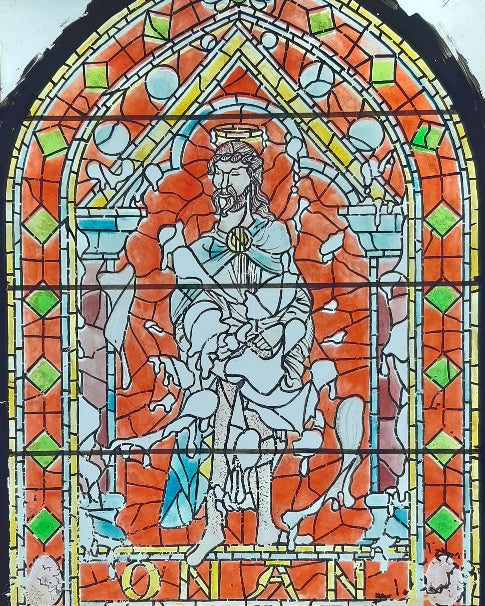ONAN. Painted Glass Window
ROSE, Alan [National Lampoon]
1974.
A original painted glass panel depicting Onan designed by Alan Rose for National Lampoon's December 1974 Issue, Vol. 1, No. 57, entitled "The Judeo-Christian Tradition. The Joy of Sects". 483x358mm. The panel, which is painted to look like traditional church stained glass, shows the figure of a man surrounded by a gothic niche which itself is placed inside a pointed arch. Beneath the human figure is the word "Onan" which identifies the man and explains the leery grimace on his face and the white splashes that surround him. In addition to the white, the glass is painted red, green, blue, yellow and mauve and pink. The edge of the pointed arch is painted with a thick black line. The edges of the glass are protected by tape. There is a small amount of scratching to the glass at the bottom resulting in a slight loss of paint but overall it is in very good condition. Alan Rose described how he made the panel from two sheets of painted glass to create the depth of image.
For the Christmas 1974 issue, National Lampoon decided to direct their “take no prisoners” anarchic satire at religion. It was surprisingly ecumenical with articles entitled “Good Friday the Rabbi Ate Pork”, “Catholic Sex Index” and “The Fatima Letter”. Much of the illustration, including this Onan stained glass window a picture of which featured in the issue, was done by Alan Rose, a friend of P.J.O’Rourke who had joined National Lampoon in 1973. Rose brought a rather more cultured and versatile style to National Lampoon’s illustrations. The magazine had a strongish devotion to Onan whom they described as the “Patron Saint of Small Families”. Onan featured in various articles over the years perhaps reflecting the magazine’s core readership of awkward teenage boys. The “Judeo-Christian Tradition” was, unsurprisingly, controversial resulting in much religious indignation and the loss of some quite hefty advertising revenue. But is has become one of the most celebrated of all National Lampoon issues and this panel is a superb, unique survival from the mad, creative energy which defined the magazine.
